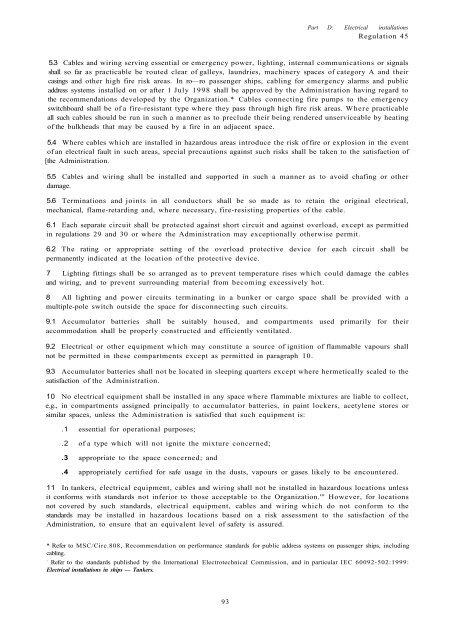Solas Consolidated Edition 2009.pdf
Solas Consolidated Edition 2009 for maritime
Solas Consolidated Edition 2009 for maritime
You also want an ePaper? Increase the reach of your titles
YUMPU automatically turns print PDFs into web optimized ePapers that Google loves.
Part D: Electrical installations<br />
Regulation 45<br />
5.3 Cables and wiring serving essential or emergency power, lighting, internal communications or signals<br />
shall so far as practicable be routed clear of galleys, laundries, machinery spaces of category A and their<br />
casings and other high fire risk areas. In ro—ro passenger ships, cabling for emergency alarms and public<br />
address systems installed on or after 1 July 1998 shall be approved by the Administration having regard to<br />
the recommendations developed by the Organization.* Cables connecting fire pumps to the emergency<br />
switchboard shall be of a fire-resistant type where they pass through high fire risk areas. Where practicable<br />
all such cables should be run in such a manner as to preclude their being rendered unserviceable by heating<br />
of the bulkheads that may be caused by a fire in an adjacent space.<br />
5.4 Where cables which are installed in hazardous areas introduce the risk of fire or explosion in the event<br />
of an electrical fault in such areas, special precautions against such risks shall be taken to the satisfaction of<br />
[the Administration.<br />
5.5 Cables and wiring shall be installed and supported in such a manner as to avoid chafing or other<br />
damage.<br />
5.6 Terminations and joints in all conductors shall be so made as to retain the original electrical,<br />
mechanical, flame-retarding and, where necessary, fire-resisting properties of the cable.<br />
6.1 Each separate circuit shall be protected against short circuit and against overload, except as permitted<br />
in regulations 29 and 30 or where the Administration may exceptionally otherwise permit.<br />
6.2 The rating or appropriate setting of the overload protective device for each circuit shall be<br />
permanently indicated at the location of the protective device.<br />
7 Lighting fittings shall be so arranged as to prevent temperature rises which could damage the cables<br />
and wiring, and to prevent surrounding material from becoming excessively hot.<br />
8 All lighting and power circuits terminating in a bunker or cargo space shall be provided with a<br />
multiple-pole switch outside the space for disconnecting such circuits.<br />
9.1 Accumulator batteries shall be suitably housed, and compartments used primarily for their<br />
accommodation shall be properly constructed and efficiently ventilated.<br />
9.2 Electrical or other equipment which may constitute a source of ignition of flammable vapours shall<br />
not be permitted in these compartments except as permitted in paragraph 10.<br />
9.3 Accumulator batteries shall not be located in sleeping quarters except where hermetically scaled to the<br />
satisfaction of the Administration.<br />
10 No electrical equipment shall be installed in any space where flammable mixtures are liable to collect,<br />
e.g., in compartments assigned principally to accumulator batteries, in paint lockers, acetylene stores or<br />
similar spaces, unless the Administration is satisfied that such equipment is:<br />
.1 essential for operational purposes;<br />
.2 of a type which will not ignite the mixture concerned;<br />
.3 appropriate to the space concerned; and<br />
.4 appropriately certified for safe usage in the dusts, vapours or gases likely to be encountered.<br />
11 In tankers, electrical equipment, cables and wiring shall not be installed in hazardous locations unless<br />
it conforms with standards not inferior to those acceptable to the Organization.''' However, for locations<br />
not covered by such standards, electrical equipment, cables and wiring which do not conform to the<br />
standards may be installed in hazardous locations based on a risk assessment to the satisfaction of the<br />
Administration, to ensure that an equivalent level of safety is assured.<br />
* Refer to MSC/Circ.808, Recommendation on performance standards for public address systems on passenger ships, including<br />
cabling.<br />
+<br />
Refer to the standards published by the International Electrotechnical Commission, and in particular IEC 60092-502:1999:<br />
Electrical installations in ships — Tankers.<br />
93


